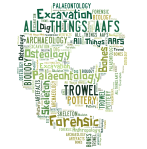
Geochemistry of the Soil and it’s Effects on Bone
My dissertation focused on the relationship between the soil, in particular soil pH and Ca/Al concentrations, and skeletal remains of in situ burial archaeology. It involved collecting soil samples from the surrounding areas of articulated skeletal remains found in cut graves and midden pits, which were being excavated from a Roman/Durotrigan site in Winterborne Kingston, Dorset (To learn more about this archaeological site, we’ve featured it in one of our Archaeology On Location posts by clicking here).
The reason for my investigation was to understand whether certain soil types could delay or increase the rate of erosion of skeletal remains whilst in situ, and if so – could we create a predictive model that could help educate us on whether certain anthropologically important sites, such as burial mounds, were at risk of being damaged waiting to be excavated. And if this was the case, could we use this information to prioritise fieldwork so that the most ‘at risk’ sites were excavated first.
I wanted to focus on area of archaeology as my dissertation topic is because I find it very interesting as I am a big fan of the conservation side of archaeology and anthropology. Another reason is that it isn’t often explored having been briefly addressed in recent times, with only three papers academically published on the topic (Gordon & Buikstra, 1981; Nielsen-Marsh et al, 2007; and Nord et al, 2005).
I really wanted to stress how important it is to preserve the skeletal remains in situ or excavate them quickly depending on their surrounding soil types and risk factor, therefore conserving our important archaeological heritage. It has been documented that skeletal remains excavated recently are in a worse condition compared to skeletal remains excavated in the 1980’s in similar soils (Nord et al, 2007), and therefore important archaeological evidence is being eroded away and lost.
Brief References:
Gordon, C.C., and Buikstra, J. E., 1981, Soil pH, bone preservation, and sampling bias at mortuary sites. American Antiquity. 46 (1), 566–71.
Nielsen-Marsh, C.M., Smither, C.I., Jans, M.M.E., Nord, A., Kars, H., Collins, M.J. 2007. Bone diagenesis in the European Holocene II: taphonomic and environmental considerations. Journal of Archaeological Sciences. 34 (9), 1523-1531.
Nord, A.G., Tronner, K., Mattsson, E., Borg, GCh., Ullén, I. 2005. Environmental threats to buried archaeological remains. AMBIO: A Journal of the Human Environment. 34, 256–262.
_____________________________________________________________________________
Dissertation Abstract:
Understanding the geochemical influences on the level of preservation of skeletal remains is very important for archaeological research to allow for controls. By investigating the different cause and effects that geochemistry has on skeletal remains, predictive models can be put in place to support future research and improve our knowledge of the relationship between soil geochemistry, and preservation and set in place necessary conservation models. Twenty-four soil samples were taken from a Durotrigan site in Dorset being excavated by Bournemouth University. Each soil sample was taken adjacently from a human or large animal articulated skeletal remain. On site categorical classification of the level of preservation was performed and recorded for each articulated remain. The soil samples were air dried and sieved and the less than 1mm track was then completely digested using a mix of 6ml HCl and 2ml HNO3 and a Multiwave 3000 Anton Parr microwave. Digested samples were then filtered and brought to a 50ml volume and then run through an inductively couples plasma optical emission spectrometry (ICP-OES). The pH level of the soil sample along with the heavy metals concentration was then determined. SPSS was used along with linear regression lines to obtain correlation co-efficients. The level of bone preservation was found to be in moderate correlation with the pH level of the soil. Due to Ca ions and Al ions having the most influence on pH levels, the ion concentrations were correlated against the pH level to identify any cause and effect relationships. Ca concentration and pH was found to have a weak relationship. This study identifies what cause and effect relationships pH and heavy metal concentrations have within soil geochemistry and recognise the detrimental effects they can have within forensic and archaeological contexts and with buried archaeological remains which will threaten the quality of future excavations.
Keywords: Anthropology, Bioarchaeology, Bones, Geochemistry.
If you would like to read more of my dissertation, you can view the full .pdf here:
Geochemistry of the Soil and it’s Effects on Bone – Rosemary Helen Mayne – Dissertation 2013
